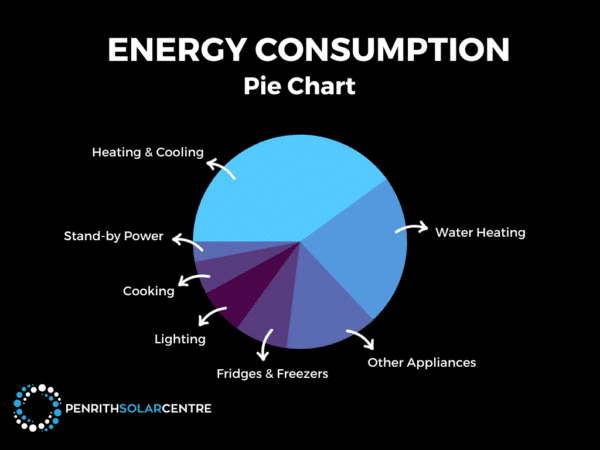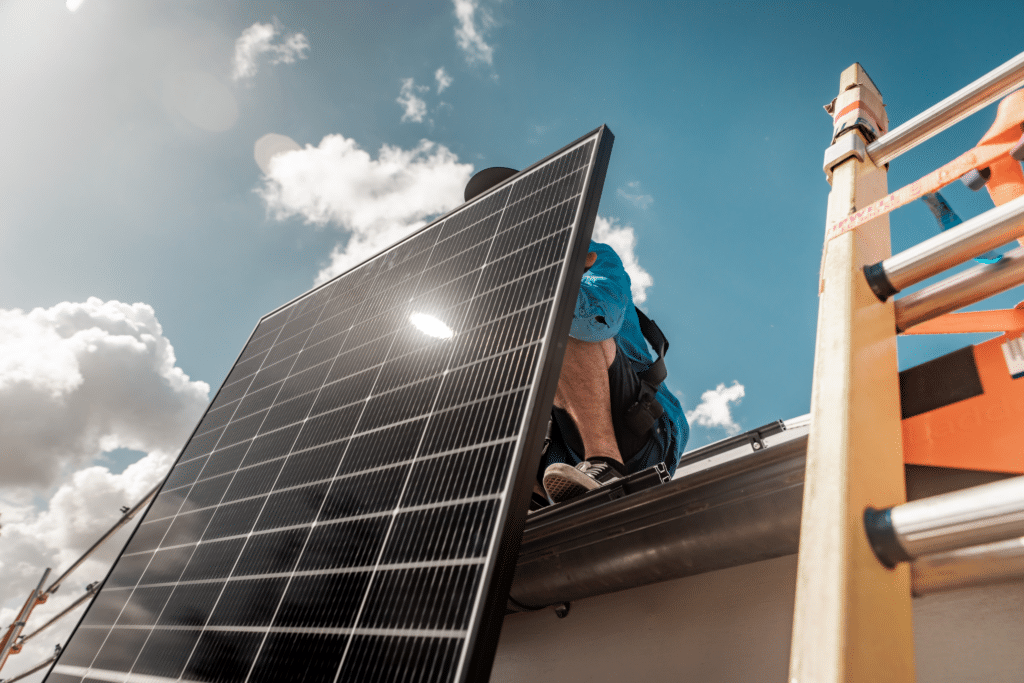How big do you need your solar system to be? That’s the question, isn’t it? More than a few salespeople will tell you that you need a big one. Maybe you do. It’s also possible that you might not.
Everyone’s home is different, and everyone’s energy needs are different. Some people have a large home and a large family, some have a small home and are single. The simple fact of the matter is that like so many questions in the solar industry, the correct answer to this question is:
It depends.
Oh, man, we did it again, didn’t we? Yet another article with the phrase “it depends” when you’re looking for a straight answer. It does depend on a few factors. Let’s get into it.
At Penrith Solar Centre, we are a top to bottom, in-house solar installer with years of experience in evaluating the energy consumption patterns of our customers. As much as we want to install solar and keep the company as a leader in the Sydney marketplace, our goal is to help Australia reach Net Zero by 2050. Part of achieving that goal is to educate our readers with the correct information about solar energy without the stress of signing on the dotted line.
You can’t install a solar system until you buy one, and you can’t buy one until you know what size system you’ll need and what accessories you’ll need to go with it, and you can’t determine that until you know what your electricity needs are, and you really have no idea what they are until you evaluate your energy consumption patterns.
Whew!
In this article, you will learn the following:
- What are Energy Consumption Patterns?
- How Do You Determine Your Energy Needs?
- How Do Energy Needs Guide Your Solar Purchase?
- How Do Energy Needs Affect Your Solar Installation?
- What Are Peak Sun Hours?
By the end of this article, you will have a comprehensive view of what you need to consider when shopping for a solar system. It’s so much more than simply putting some panels up on your roof. It’s an investment that will save you money and just might save the planet.
What are Energy Consumption Patterns?
“Energy consumption pattern” is a fancy-pants phrase that folks in the solar industry like to throw around. It’s fun lingo once you get the hang of it. Give it a shot: energy consumption patterns. Fun, right?
It’s a phrase that refers to how a household uses energy every day.
- Energy = Electricity in your home. It runs your lights and appliances. Pretty self-explanatory, right?
- Consumption = How you use a resource. In this case, electricity.
- Pattern = We all know this one: it’s a repeatable design or sequence.
When you put them all together, we’re talking about how electricity is used repeatedly in your home.
Next time you talk to a solar salesperson, just casually drop the phrase into your conversation and wait for their reaction. It’ll be good.
How Do You Determine Your Energy Needs?
How do you use electricity?
Before I started writing about solar systems, I rarely gave my energy usage any consideration except for the quarterly bills I received. Of course, I would do things like go around the house turning off lights, because when I was a kid, my parents would hassle me about doing exactly that to keep the energy bill low.
Spend some time figuring out when you are typically at home and how much electricity you use during that time. The answers to the following questions are part of your energy consumption patterns.
- Daily Routine: What does your typical daily routine look like? Are you usually at home when the sun is shining, or does your energy usage peak in the evening? For most people, it’s in the evening.
- Appliance Usage: Consider the appliances you use and the times you operate them. Are you running energy-intensive appliances during the day, or do you primarily use them in the evening?
- Seasonal Changes: Consider the seasons. Your heating and cooling requirements vary with the weather. For example, you may use air conditioning more in the summer, affecting your electricity consumption differently than in the winter. Also, your lighting preferences will change with the season. You’ll need light after 5pm in the winter.
- Seasonal Activities: Think about any seasonal activities that may impact your electricity usage, such as increased use of a pool pump in the summer.
The energy consumption patterns of most households tend to follow a similar pattern. Homes in the Sydney metro area typically use electricity in the morning and in the afternoon/evening hours, as residents often work or attend school in the middle of the day.
It’s as simple as figuring out a few key questions and answering them.

How Do Energy Needs Guide Your Solar Purchase?
The more energy you use, the larger the system you’ll need to save money and reduce your reliance on the electric grid. Similarly, the less energy you use, the smaller the system you’ll need. However, we do recommend installing a system that is easily expandable in the future as electricity needs might change – drastically even – in the future as the current energy crisis we’re in unfolds.
Families with school-age children will most likely use more energy in the morning than households without children. Kids wake up early and turn everything on. Parents are pretty likely to cook breakfast for kids and themselves whereas a couple living together might skip turning on the TV and have coffee for breakfast.

Both types of households will certainly use a lot of energy in the evening. The family gets home from school and work and needs electricity to see them through the evening hours just as much as a household without children.

Households with infants, people who work from home, and households with retirees are a different story. If a household has small children and a parent is home all day with them, then the electricity needs will be different throughout the day. The same goes for people who work from home and retirees who are home all day.

Solar systems with the best return on investment are the ones that best match the solar output to the energy requirements of the household.
Not long ago, solar companies were suggesting a 6.6kW system for most households. A lot of this had to do with the limitations of string inverters in relation to the electrical grid. A 6.6kW solar system outputs approximately 26kWh or energy.
Today, most households really need a system larger than that. Times have changed. Australians are investing in bigger systems because electricity is getting more expensive. Their needs are also greater. And their needs in the future are estimated to be even greater with the emergence of electric vehicles and other home energy solutions.
Be careful when shopping for quotes because a lot of janky solar companies still recommend a meagre 6.6kW system.
Homeowners frequently choose a larger system size to accommodate potential growth in energy usage. Several factors can significantly increase your home’s electricity consumption. These include installing an air conditioning unit, adding a granny flat or second dwelling, putting in a swimming pool, converting gas to electric (stove, hot water, heating), working from home, buying an electric vehicle, or installing a solar battery.
If you anticipate incorporating any of these plans into your home, it’s a good idea to consider adding more capacity to your solar system upfront. This helps avoid a more costly process of expanding the system later on. At the very least, you should consider investing in a microinverter system which is exponentially easier and cheaper to upgrade than a string system.
For more information regarding the differences between microinverters and string inverters, you might want to check out the following article titled, Microinverters vs. String Inverters: An Honest Comparison.
How Do Energy Needs Affect Your Installation?
Because you’re using your electricity in the morning and afternoon/evening, you might want to consider installing panels to match that consumption pattern: one-third of the panels go on the eastern roof, and two-thirds on the western side. It keeps the home running well from morning to evening based on energy consumption patterns. More energy is used in the afternoon, so this design benefits that.
At Penrith Solar Centre, we call this the 2/3 rule. A third of your total solar panels should be installed on the eastern-facing roof to capture the sunlight in the morning when your household is getting ready for the day. Two-thirds of your solar panels should be installed on the western-facing part of your roof to best capture the sunlight from the sun as it makes its way to the horizon, powering your home after you get back from work.

This doesn’t mean that the north-facing rooftop will be ignored. If there’s room on the northern-facing part of the roof, then that real estate should be used. Realistically, most rooftops need as many solar panels installed on them as can be fit for maximum efficiency. Rooftop space is limited by the design of the home.
Not everyone uses energy in the middle of the day, so having energy in the afternoon is crucial if you don’t have a battery. A mix of east and west-facing panels can be a smart choice for solar efficiency, especially if you use energy later in the day.
Once you start to evaluate your energy consumption patterns and what your energy needs truly are, you’ll start to understand that northern-facing panels aren’t the only place to install solar. East/west panel installation might be more efficient than northern-facing panels depending on how you use energy.
If you’re interested in a deeper perspective and more specific examples of how energy consumption patterns affect your solar panel placement, you might be interested in reading this article titled, Can You Install Solar Panels on a South-facing Roof in Australia?
What Are Peak Sun Hours?
Finally, you need to determine how much electricity your solar system will be able to produce (on average, not accounting for seasonal changes). Bigger solar systems produce more energy than smaller systems. There are a variety of other factors that influence how much electricity those panels can generate. One of the most important factors in calculating how much that system can output is determining peak sun hours.
Peak sun hours are the time of day when your solar panels are most efficient. The average peak sun hour timeframe is about 3 – 5 hours during midday. Nonpeak hours are all the other hours in the day when the sun is shining on the panels but not at its maximum efficiency.
Peak sun hours are an important part of calculating how much electricity your solar system will deliver to your home. It’s the amount of time when the intensity of the solar radiation (we’re talking about sunlight here) is on average 1000 watts of energy per square meter.

A peak sun hour is 1000W per square meter of sunshine for 1 hour.
This is how we do the math to figure that out:
Peak sun hours x solar system kilowatts = amount of kilowatt hours it can produce daily.
Peak sun hours are necessary for determining if solar panels can generate enough power to run your home and provide a return on investment. The amount of sunlight a home receives, along with the intensity of the sun’s rays, depends on its location.
Knowing the average peak sun hours for your home’s geographic location is needed in figuring out how many solar panels will go up on your roof. You need to calculate how many kilowatts your home will use in a day, which will inform choices about how many solar panels will be needed.
Because you don’t know how many solar system kilowatts you have (because your solar system is not yet installed), you’ll have to rearrange the above equation to figure out your solar system size. It’s just like math class when you were in school trying to figure out the missing integer.
You have the amount of peak sun hours for Sydney, and you know how many kilowatt hours your home produces in a year (because you read it on your electricity bill). The equation for determining the number of kilowatts your solar system will need to output is as follows:
Kilowatt hours your home produces daily / peak sun hours = daily solar system kilowatts.
In Sydney, the peak sun hours are 3.9. The peak sun hours are the maximum efficiency of the panels (on a sunny day) that your solar system will output.
Over the course of one year, your home used 10,000kWh of electricity (we’ll use a nice round number, so the math is easier).
You start by dividing 10,000kWh / 365 days in a year to determine that you will use (on average not accounting for seasonal changes) about 27.4kWh per day.
Next, you take the 27.4kWh per day and divide it by / 3.9 peak sun hours per day to get = 7.03kW. You need a solar system that produces at least 7.03kW every day to power your home.
In the summertime, there will be more peak hours and in the winter there will be fewer.
The sun’s intensity varies during the day, depending on the time and weather. Your panels may only output 500W/meter squared at 8 AM and again at 5 PM.
Peak sun hours give us the best idea as to how much electricity a solar system can generate on average in ideal conditions.
Harvesting that energy in ideal conditions depends on some other factors too – things like latitude, longitude, pitch, orientation, and azimuth.
For more insight into how the placement of your solar panels affects the efficiency of your solar system (and what all those fancy words we just used in the previous paragraph mean), you might want to check out the following article titled, Which Way Should Solar Panels Face in Australia?
Energy Consumption Patterns: Wrapping Things Up
Now you are an expert in what to consider about your needs when shopping for solar. By thoroughly reviewing and assessing your electricity needs, you’ll have a better grasp on what you need from a solar system.
A reputable installer is an important part of the solar shopping process. A good installer will ask you questions about your energy consumption patterns to determine your unique needs. If they don’t, you might want to find someone else to talk to about your solar purchase. How you use electricity influences every choice you’ll make about your solar system.
At Penrith Solar Centre, we want to inform you about every step of the process when it comes to installing solar on your home. We want you to understand that your needs are unique and we’re here to help you on your solar journey.

If you’re interested in learning more about determining the cost of a solar system and the things you’ll need to consider, you might want to check out the following article titled, How Much Does a Microinverter Solar System Cost?









